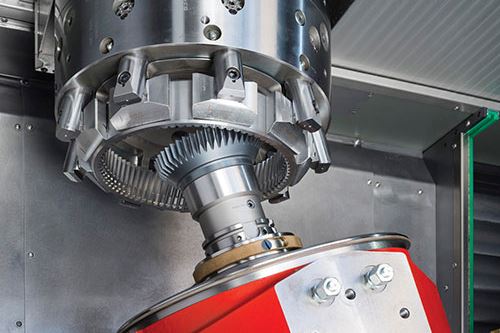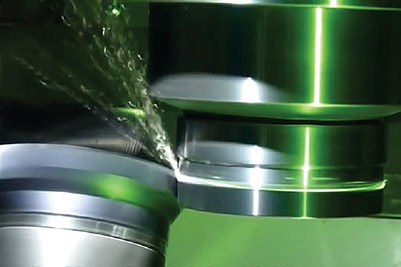The Evolution of Gear Scudding
In gear scudding, the workpiece is machined with a 60-tooth scudding cutter at a speed of 4,000 rpm, achieving 240,000 cuts per minute—as much as 10 times faster than shaping.
One of the key factors in increasing productivity is eliminating wasted motion. That’s just one of the benefits of gear scudding, a continuous generating process also known as skiving. In this process the movement of the cutting tool and workpiece are synchronized and feed directly through the material, eliminating unproductive upstrokes and reducing cycle times below shaping. Additional benefits include high gear quality (AGMA 10-12, DIN 5-7), an excellent surface finish (Ra 2.0-0.30/Rz 6.0-0.90) and the ability to machine hardened workpieces using carbide tooling.
Based on a German green-gear process called walzschälan, or “hob peeling,” scudding was originally developed to produce sliding-sleeve internal splines for manual transmissions for the automotive industry by Pittler T&S GmbH in the early 1900s. However, the limited power of the machine tools of that time could not meet the demands of the process. Due to this, interest waned. As technology progressed, scudding was re-introduced by Profilator GmbH at EMO 2007 and is now sold by its North American subsidiary German Machine Tools of America (GMTA), which also represents the Pittler line of vertical turning centers in that region. It was quickly recognized as an ideal process for manufacturing internal and external gears, as well as spur and helical gearing and non-symmetrical forms.
According to Scott Knoy, vice president of sales and marketing at GMTA, if a form can be generated via shaping, broaching or hobbing, then it is a candidate for scudding. An example of the potential speed would be a workpiece that is machined with a 60-tooth scudding cutter at a speed of 4,000 rpm, achieving 240,000 enveloping cuts per minute. This means scudding can be up to 10 times faster than gear shaping. And there are no wasted strokes in scudding, whereas broaching plunges the tool through the center of the workpiece for the cut, and then the tool must be withdrawn before the next cycle can begin. Additionally, scudding can make lead corrections including crown and taper using the machine axes, which is not possible in broaching. Although hobbing still provides longer tool life, as there are more teeth on the hob than on the typical scudding cutter, the scudding process parameters—which consist of high cutting speeds and feeds—allow it to consistently provide a better surface finish than hobbing, resulting in higher AGMA-quality gears.
Cutting tools for the Profilator scudding machines, available through a collaboration between GMTA and Star SU, both resemble and cost about the same as a shaper cutter, although the microgeometry is somewhat different. The design allows for cuts to be made within a few millimeters of some shoulders, which is comparable to shaping. Moreover, scudding eliminates the need for an undercut, eliminating a turning procedure to provide a clearance groove for shaping. In addition, deburring is simplified since scudding generally produces only surface burrs, which can be clipped off with an insert or, in many cases, are removed by the heat-treating process. In all cases, Profilator scudding is a dry cutting process, as opposed to skiving, which requires the use of a coolant.
Read Next
The Cut Scene: The Finer Details of Large-Format Machining
Small details and features can have an outsized impact on large parts, such as Barbco’s collapsible utility drill head.
Read More3 Mistakes That Cause CNC Programs to Fail
Despite enhancements to manufacturing technology, there are still issues today that can cause programs to fail. These failures can cause lost time, scrapped parts, damaged machines and even injured operators.
Read More









.png;maxWidth=300;quality=90)









